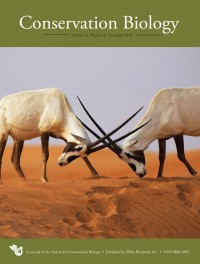
ISSN: 0888-8892
Journal Home
Journal Guideline
Conservation Biology Q1 Unclaimed
Conservation Biology is the most influential and frequently cited journal in its field. The journal publishes groundbreaking papers and is instrumental in defining the key issues contributing to the science and practice of conserving Earth’s biological diversity.Conservation Biology welcomes submissions that address the science and practice of conserving Earth's biological diversity. We encourage submissions that emphasize issues germane to any of Earth's ecosystems or geographic regions. It has an SJR impact factor of 2,222.
Conservation Biology focuses its scope in these topics and keywords: conservation, biodiversity, impacts, management, network, river, ala, alternative, amazonians, american, ...
Type: Journal
Type of Copyright:
Languages: English
Open Access Policy: Open Choice
Type of publications:
Publication frecuency: -


2500 €
Inmediate OANPD
Embargoed OA0 €
Non OAMetrics
2,222
SJR Impact factor257
H Index219
Total Docs (Last Year)500
Total Docs (3 years)16518
Total Refs3080
Total Cites (3 years)459
Citable Docs (3 years)5.57
Cites/Doc (2 years)75.42
Ref/DocOther journals with similar parameters
MMWR. Morbidity and mortality weekly report Q1
Annual Review of Public Health Q1
Annual Review of Clinical Psychology Q1
Journal of Thoracic Oncology Q1
Lancet Digital Health, The Q1
Compare this journals
Aims and Scope
Best articles by citations
Biological Consequences of Ecosystem Fragmentation: A Review
Indicators for Monitoring Biodiversity: A Hierarchical Approach
A Method for Assessing Hydrologic Alteration within Ecosystems
Correlation between Fitness and Genetic Diversity
Review of Ecological Effects of Roads on Terrestrial and Aquatic Communities
Disturbance, Diversity, and Invasion: Implications for Conservation
Habitat Loss and Extinction in the Hotspots of Biodiversity
Command and Control and the Pathology of Natural Resource Management
Relationship of Genetic Variation to Population Size in Wildlife
The Global 200: A Representation Approach to Conserving the Earth’s Most Biologically Valuable Ecoregions
A Survey and Overview of Habitat Fragmentation Experiments
Quantification of Extinction Risk: IUCN's System for Classifying Threatened Species
Identifying Populations for Conservation on the Basis of Genetic Markers
Extinction Rates of North American Freshwater Fauna
Five Potential Consequences of Climate Change for Invasive Species
Edge Influence on Forest Structure and Composition in Fragmented Landscapes
Scenario Planning: a Tool for Conservation in an Uncertain World
Assessing the Effects of Climate Change on Aquatic Invasive Species
Developing the Science of Reintroduction Biology
Dispersal and Landscape Errors in Spatially Explicit Population Models: a Reply
View moreDemography of Two Mexican Spotted Owl Populations
View more
Comments